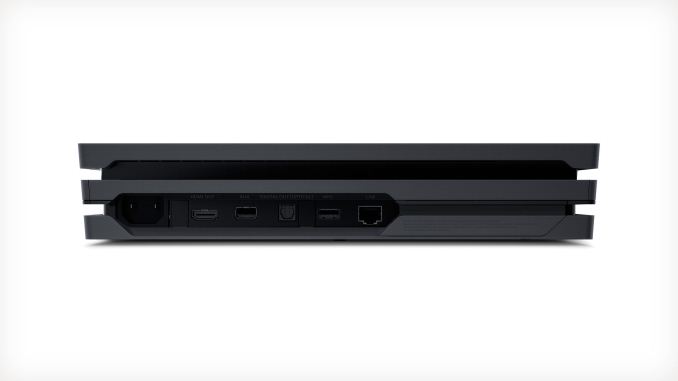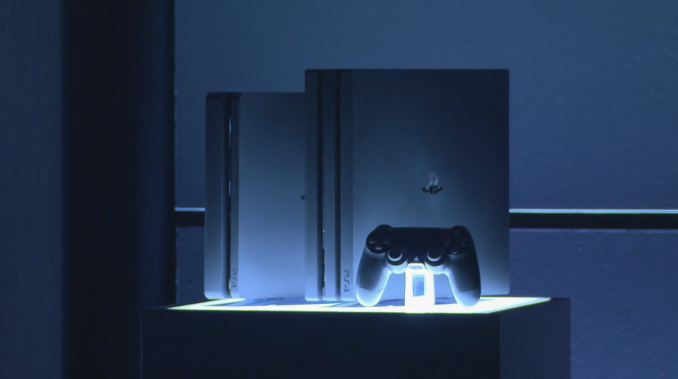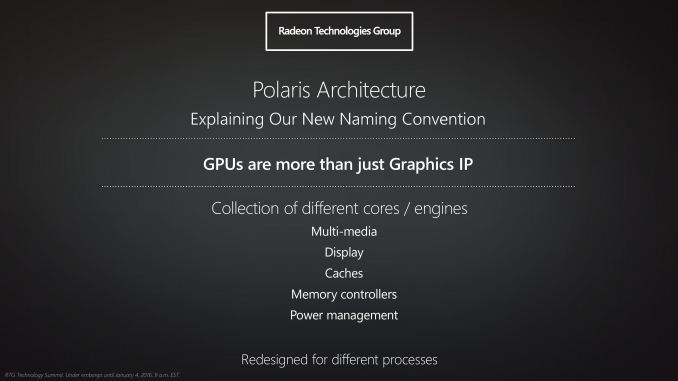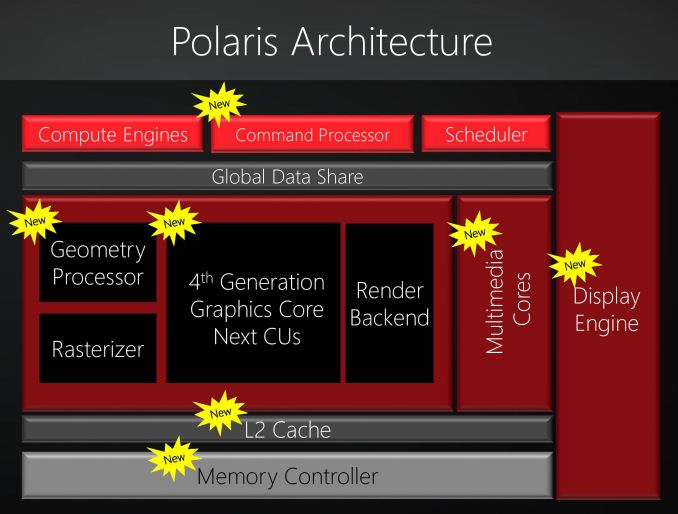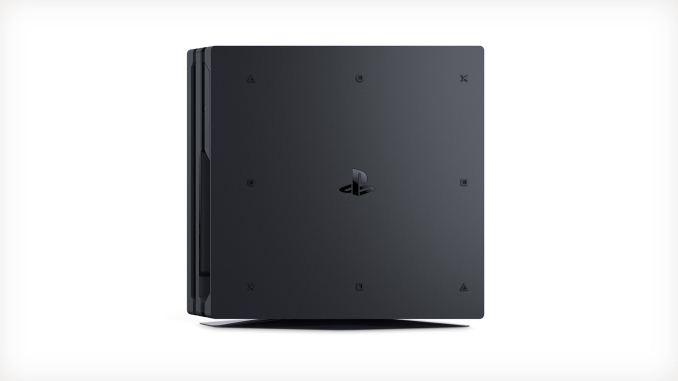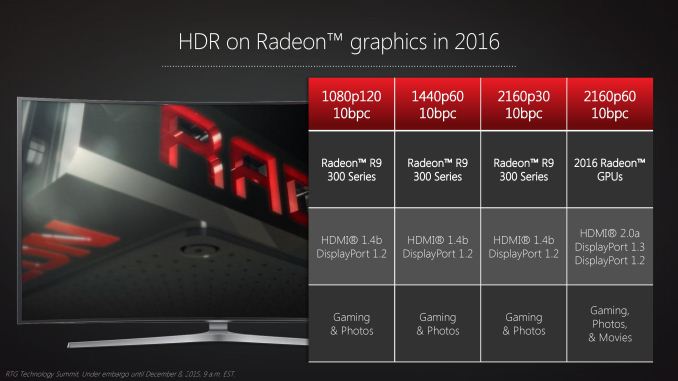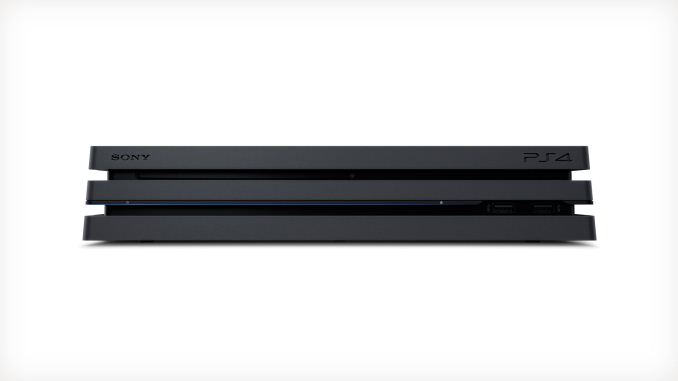
Original Link: https://www.anandtech.com/show/10663/analyzing-sonys-playstation-4-pro-announcement
Analyzing Sony’s PlayStation 4 Pro Hardware Reveal: What Lies Beneath
by Ryan Smith on September 8, 2016 8:00 AM EST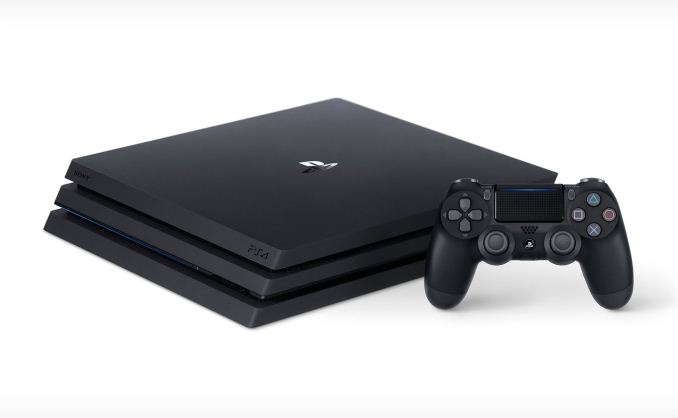
A few months ago near the start of E3, Sony made an interesting revelation: that they would be releasing a higher performing PlayStation 4 console. A console intended to complement the standard/slim model, this faster PlayStation would be an unusual – if unprecedented – mid-generation update of sorts for Sony’s console family. Previous generations of consoles have offered add-ons, but a significantly faster model is something else entirely.
In any case, after much speculation and a fair bit of analysis on how the PlayStation 4 ecosystem would work with multiple models, in an event in New York City this afternoon, Sony announced the new console. Dubbed the PlayStation 4 Pro, it would sit alongside the newly launched slimmer PS4 (an original PS4 with a die shrunk SoC) as a premium, more powerful entry in the PlayStation 4 family. The console is intended to cover a spectrum of use cases for Sony, including 4K TV support, HDR, better VR performance, and higher fidelity graphics on today’s 1080p TVs.
As AnandTech is not a gaming website, I’m going to skip the gaming ramifications. Instead, let’s do what we do best and dive into the hardware.
PlayStation 4 Pro: AMD’s Next Semi-Custom SoC Win
A bit to my surprise, Sony actually released some basic specifications about the underlying hardware. The information is similar to what we were given close to the PS4 launch, but at the same time I wasn’t expecting this information until we were closer to the PS4 Pro’s November launch.
| Sony PlayStation 4 Spec Comparison | ||||||||||||||
| PlayStation 4 (OG) | PlayStation 4 (Slim) | PlayStation 4 Pro | ||||||||||||
| CPU Cores/Threads | 8/8 | 8/8 | 8/8 | |||||||||||
| CPU Frequency | 1.6GHz | 1.6GHz | > 1.6GHz | |||||||||||
| CPU µArch | AMD Jaguar | AMD Jaguar | AMD Jaguar | |||||||||||
| Shared L2 Cache | 2 x 2MB | 2 x 2MB | 2 x 2MB? | |||||||||||
| GPU Cores | 1152 (18 CUs) | 1152 (18 CUs) | 2304 (36 CUs)? | |||||||||||
| Peak Shader Throughput | 1.84 TFLOPS | 1.84 TFLOPS | 4.20 TFLOPS | |||||||||||
| System Memory | 8GB 5.5 Gbps GDDR5 | 8GB 5.5 Gbps GDDR5 | 8GB ? Gbps GDDR5 | |||||||||||
| System Memory Bus | 256-bits | 256-bits | 256-bits | |||||||||||
| System Memory Bandwidth | 176.0 GB/s | 176.0 GB/s | 176.0 GB/s? | |||||||||||
| Optical Drive | 6x BD | 6x BD | 6x BD | |||||||||||
| Power Consumption (Up To) |
250W? | 165W | 310W | |||||||||||
| HDMI | 1.4 | 1.4 | 2.0 | |||||||||||
| Manufacturing Process | 28nm | 16nm? | 16nm? | |||||||||||
With a focus on increased performance, the heart and soul of the PS4 is a new, higher performance SoC from AMD. One of AMD’s semi-custom design wins for H2’16, Sony has released certain details that help paint a useful, though not quite complete picture of what this SoC can do.
On the CPU side, Sony is not officially discussing clockspeed. However they have confirmed that it is still an 8 core Jaguar design like the original PlayStation, so there are no additional CPU cores in play. Furthermore the CPU clockspeed has been boosted by an undisclosed amount, so total CPU performance has increased.
While I have some ideas on what those numbers may be, it does depend in part on how much work AMD put in on the semi-custom stage of the design process. The newer manufacturing process – which I believe to be TSMC’s 16nm since that is AMD’s regular semi-custom fab partner – certainly delivers some benefits. But at the same time the Jaguar architecture was not originally designed to scale to very high clockspeeds – keep in mind that this was a low power architecture to begin with – so there are frequency bottlenecks besides simple silicon limits. For reference, the fastest desktop Jaguar desktop processor topped out at 2.2GHz. Unless AMD has done any major reworking of Jaguar for Sony, that is about as good of a guess as we can make, short of Sony confirming any numbers.
Meanwhile on the GPU side, things get a lot more interesting. The PS4 Pro’s SoC features a far more powerful integrated GPU, more than doubling the rated performance of the original PS4. Overall the PS4 is rated for 4.2 TFLOPs, versus 1.84 TFLOPs on the original console. In terms of raw throughput, this is to AMD’s current-generation mainstream discrete GPUs, offering throughput somewhere between the RX 470 (4.9 TFLOPs) and the R9 380X (4.0 TFLOPs).
The significant increase in GPU performance is easily the biggest selling point of the new console, and is the cornerstone of Sony’s plans to pitch the console as a higher fidelity alternative to the stock PS4. This includes both higher quality rendering (e.g. more objects, better shadows, etc) and higher framerates, but also higher resolutions as well as part of Sony’s greater push to make the PS4 Pro synonymous with 4K.
As far as the GPU configuration goes then, officially we don’t have anything to work with besides the raw throughput. Clockspeeds and CU counts are both very good questions right now, as the jump to 16nm will have improved both AMD’s ability to pack in more CUs in a given area, and, at least to some extent, rev up the clockspeeds. So how AMD has opted to balance these factors is an interesting question.
Given that GPU throughput has increased by 2.3x, my hunch is that AMD has pushed both aspects. A straight doubling in the CU count coupled with a modest (14%) increase in the GPU clockspeed would reach the stated performance numbers without too radical of an alteration of the GPU architecture. But there’s a lot of wiggle room here; it could just as easily be 34 CUs at a higher clockspeed, for example. A wider design favors power efficiency – which is always a boon in a console – but as 16nm is still a newer process, it’s a chip yield risk.
Meanwhile, it’s important to note here that as we’ve seen in the discrete GPU space, shader throughput is not everything. Shaders are indeed frequently the biggest bottleneck to GPU performance, but they are hardly the only one. One way or another AMD has greatly increased the shader throughput of their SoC, but rather they’ve increased the unit counts on any other aspects remains to be seen. Whether they’ve added additional geometry units or ROPs could significantly influence the performance of the console, as it’s going to be relatively harder to fill up those expanded shader resources if these other resources weren’t similarly expanded. At the same time we don’t know anything about how the GDDR5 memory is clocked; I think it’s a safe bet that it’s clocked higher since the original console was only at 5.5Gbps, but even 7Gbps memory would only be 27% more memory bandwidth to feed a much wider GPU. In short, it’s best not to assume that all aspects of the GPU have been doubled, and consequently that the real world performance advantage for the PS4 Pro is not going to be quite as great as the GPU specs indicate.
On that note, while Sony is pitching the console for 4K video and gaming, Mark Cerny was rather clear that to reach 4K gaming, they expect developers to make significant use of both spatial and temporal anti-aliasing/reprojection.to reach 4K. In other words, most of the time the console won’t actually be rendering games at 4K. This makes a lot of sense; all else held equal, the PS4 Pro needs to fill 4x as many pixels with a GPU that’s (at best) 2.3x as powerful.
This means that the number of games that natively render at 4K is by necessity going to be relatively few. Games could still render at resolutions over 1080p (e.g. 2560x1440), giving them more fidelity than current 1080p games, but various upscaling/reprojection methods will have to close the gap to 4K. Given that even the best PC GPUs have only recently reached the performance level to render the necessary 8.3Mpixels without significant quality compromises, and we’re likely a generation (or more) from consoles being able to reach that same level.
The Polaris Connection
Meanwhile perhaps the most surprising aspect of Sony’s announcement isn’t the specifications reveal, but rather that Mark Cerny directly referenced AMD’s Polaris architecture, stating that Sony/AMD "adopted many new features from the AMD Polaris architecture." This is a statement that has a lot of ramifications, but also a statement where nuance is critical because it’s so vague.
To examine the Polaris connection, let’s take a step back in how AMD develops their GPU families. While we like to think of architectures as a monolithic thing- that every aspect of an architecture is built specifically for that given architecture – the truth is quite different. Internally, AMD’s GPUs are developed in block fashion; each major functional unit can be developed separately, and AMD can mix and match the two. Typically, but not always, a major discrete GPU generation contains the latest versions of all of these blocks. Meanwhile semi-custom wins can get a lot murkier since the business is based around AMD being able to integrate just the parts that a customer needs.
Polaris is a great example of this. Compared to Fiji (GCN 1.2), AMD revised the command processor, the display controller, the multimedia engines and the geometry processor. Meanwhile the all-important shader cores were technically revised, but in practice other than increased internal memory, they are ISA-identical to GCN 1.2. Finally, AMD did not touch the render backends, the rasterizer, or the work scheduler at all.
This means that Sony can equally pick and choose which parts of the GPU they want to update, which is important given the forward compatibility mandate of the PS4 Pro. Adopting features from Polaris does not mean that this is a full Polaris GPU.
Given the updated specifications of the console, I think it’s safe to assume that AMD has integrated their newer generation display engine and multimedia engine. The former is necessary to add support for HDMI 2.0 – critical for the console’s 4K display capabilities – while the latter is equally necessary to support 4K video decoding, including the most recent HEVC format that 4K services have been preferring.
Beyond that, however, there’s nothing that definitively points to the PS4 Pro’s SoC integrating other, newer components from Polaris. An updated memory controller would make a lot of sense if the memory clockspeeds are higher, but whether the shader cores or geometry engine have been touched are both very good questions. The PS4 has previously been described as using a GCN 1.1-era shader core, so it’s not impossible that it simply uses a larger version of such core (as opposed to Polaris’s GCN 4) to ensure compatibility. Essentially Sony & AMD’s options run the gamut from a truly updated PS4 SoC to a Polaris 10 stuffed into an SoC, and depending on Sony’s technical needs, both options would be valid.
Power Consumption, HDR, & Closing Thoughts
Finally, also on Sony’s official spec sheet is the maximum (“up to”) power consumption of the console. These values aren’t comparable to the TDPs we’re accustomed to with discrete video cards, but they’re useful for intra-PlayStation comparisons.
In this case, Sony has published that the PS4 Pro has an up to power consumption of 310W. We don’t have a similar official number for the original PS4, however its PSU is widely reported as being rated for up to 250W. Meanwhile we do have a similar number for the new slim PS4, which is 165W. So right off the bat we can see that the PS4 Pro’s maximum power consumption is significantly higher than its slim sibling, and still higher than its original 28nm generation counterpart.
Even with the move to 16nm, it’s not possible to improve an SoC in this fashion without increasing the power consumption. The GPU alone offers better than 2x the throughput of the 28nm console, and the Jaguar cores are clocked higher as well. Though it doesn’t look like we’re approaching the extreme power consumption of the likes of the original PlayStation 3, it’s clear that power consumption has gone up for the PS4 Pro, and that relative to the comparable slim PS4, there’s a significant power cost for the console’s much improved capabilities. Which is by no means unexpected, but it’s interesting to see Sony willing to build a bit bigger, bit more power hungry console than what they did with the original PS4.
Meanwhile, it’s worth pointing out that Sony has opted to equip the console with the same 6x BD-ROM drive as used in the other models, meaning that the PS4 Pro cannot play Ultra-HD Blu-Ray discs. Given Sony’s stake in the development of the Blu-Ray standards, this is a bit surprising. From a technical perspective I have no doubts that the SoC is capable of all of the necessary video decode and DRM responsibilities, as the requirements for streaming 4K services are similar, if not higher. So perhaps this is about licensing fees, or drive costs, or just that Sony is betting on the future of streaming over the future of optical disks.
Speaking of video, though I haven’t covered it in depth, HDR is a major focus for Sony as well. PS4 Pro obviously gets it, and thanks to the presence of HDMI 2.0, it gets the best support for it. Going by previous statements from AMD on GPU architectures, PS4 Pro should be fully capable of HDR for gaming, photos, and movies.
And in a surprise announcement, Sony also announced that they are backporting HDR support to the new slim PS4 and the original PS4. Looking again at our chart, we see how this can work: AMD’s older display controller (represented here by the Radeon 300 series) can support HDR, even over HDMI 1.4b. However there’s a bit more uncertainty in just what the older consoles can do with HDR. In the dGPU space, the lack of HDCP 2.2 support has been cited by AMD as one of the reasons their older GPUs can’t support HDR movies. However other Sony statements have indicated that there will be HDR support for YouTube and Netflix on the older model PS4s. So just what are technical limitations and what are contract limitations is not clear. Presumably we’ll have a better answer next week whether the original PS4 has all of the Pro’s HDR capabilities (sans 4K) or if there are further limitations that just haven’t been made clear yet.
Wrapping things up then, alongside announcing the PS4 Pro console, Sony also announced a ship date and a price. A 1TB version of console will be hitting the streets on November 10th for $399, and preorders have already started. This is the same price that the original 500GB PS4 launched at nearly 3 years ago, and $100 more than the new $299 500GB slim PS4. The slim PS4 has of course already been fully disassembled, and it goes without saying that I’m looking forward to seeing what lies beneath the new PS4 Pro once it gets its own teardown treatment.

